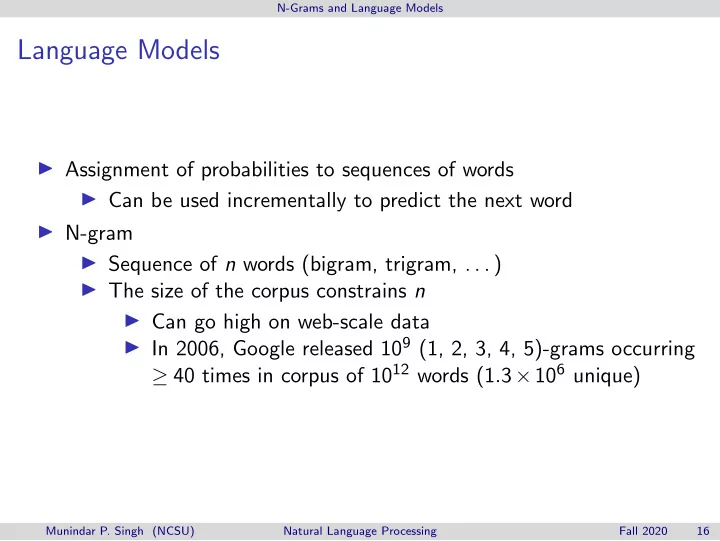

N-Grams and Language Models Language Models ◮ Assignment of probabilities to sequences of words ◮ Can be used incrementally to predict the next word ◮ N-gram ◮ Sequence of n words (bigram, trigram, . . . ) ◮ The size of the corpus constrains n ◮ Can go high on web-scale data ◮ In 2006, Google released 10 9 (1, 2, 3, 4, 5)-grams occurring ≥ 40 times in corpus of 10 12 words (1 . 3 × 10 6 unique) Munindar P. Singh (NCSU) Natural Language Processing Fall 2020 16
N-Grams and Language Models Predicting a Word Language models: bigram, trigram, n-gram ◮ Sequence of words: w 1 ... w n ◮ w j i means w i ... w j ◮ Chain rule: P ( w n 1 ) = P ( w 1 ) P ( w 2 | w 1 ) ... P ( w n | w n − 1 ) 1 ◮ Not quite usable. Why? ◮ Language use is creative ◮ Huge amount of data needed to get enough coverage ◮ Bigram: Assume P ( w n | w n − 1 ) ≈ P ( w n | w n − 1 ) 1 ◮ Trigram: Look at two words in the past ◮ n -gram: Look at n − 1 words in the past Munindar P. Singh (NCSU) Natural Language Processing Fall 2020 17
N-Grams and Language Models Maximum Likelihood Estimation (MLE) Technique to estimate probabilities ◮ Symbols for start � s � and end � /s � ◮ Obtain a corpus ◮ Calculate relative frequencies (bigram count ÷ unigram count) ◮ P ( w n | w n − 1 ) = count( w n − 1 w n ) count( w n − 1 ) Example: � s � I am Sam � /s � � s � Sam I am � /s � � s � I do not like green eggs and ham � /s � Munindar P. Singh (NCSU) Natural Language Processing Fall 2020 18
N-Grams and Language Models Evaluation ◮ Extrinsic ◮ Real-world usage ◮ Intrinsic ◮ From the data itself based on held out data ◮ Split into training and test data ◮ Safer to split into training, development (devset), and test data ◮ n-fold testing Munindar P. Singh (NCSU) Natural Language Processing Fall 2020 19
N-Grams and Language Models Perplexity Lower is better ◮ N th root of the inverse probability of the test set = P ( w 1 ... w N ) − 1 / N PP ( W ) � 1 = N P ( w 1 ... w N ) � ∏ N 1 = N i P ( w i | w 1 ... w i − 1 ) ◮ Weighted average branching factor of a language ◮ Branching factor: the number of possible next words that can follow any word ◮ Weighted by probability ◮ Calculate for the Sam I Am stanza Munindar P. Singh (NCSU) Natural Language Processing Fall 2020 20
N-Grams and Language Models Sparsity ◮ Rare n-grams may not appear in the corpus ◮ Zero count ⇒ Estimated probability of zero Munindar P. Singh (NCSU) Natural Language Processing Fall 2020 21
N-Grams and Language Models Unknown (Out of Vocabulary) Words ◮ Closed vocabulary ◮ Assume all unknown words are the same � UNK � ◮ Open vocabulary ◮ Treat all rare words as the same � UNK � ◮ Treat the top N most frequent words as words and replace the rest by � UNK � ◮ The number of unknown words can be over-estimated when a language has complex inflected forms ◮ Stemming can reduce (apparent) unknowns but is a coarse approach ◮ Perplexity can be lowered by making the vocabulary smaller Munindar P. Singh (NCSU) Natural Language Processing Fall 2020 22
N-Grams and Language Models Smoothing ◮ Calculate for the Sam I Am stanza as a corpus ◮ Adjusted counts, c ∗ ◮ Discounting (i.e., reducing) of the nonzero counts ◮ Frees up some probability mass to assign to the zero counts ◮ Laplace: add 1 to each count ◮ Simple ◮ Invented by Pierre-Simon Laplace in the early days of Bayesian reasoning ◮ Since there so many zero count bigrams, Laplace takes away too much probability mass from the nonzero counts ◮ Add k smoothing ( k < 1) ◮ Requires tuning, via devset Munindar P. Singh (NCSU) Natural Language Processing Fall 2020 23
N-Grams and Language Models Backoff ◮ Backoff: Reduce context when insufficient data ◮ If not enough trigrams, use bigram (of last two) ◮ If not enough bigrams, use unigram ◮ Interpolation: combine all n-gram estimators ◮ Linear combination of probabilities estimated from unigram, bigram, trigram counts ◮ Use held-out corpus to estimate Munindar P. Singh (NCSU) Natural Language Processing Fall 2020 24
N-Grams and Language Models Kneser-Ney Smoothing ◮ Based on an empirical observation ◮ Get counts of n-grams from one corpus ◮ Get counts of the n-grams from a held-out corpus ◮ The average counts in the second corpus are lower by about 0.75 (or 0.80) for bigrams ◮ Bigrams of count zero are more popular in the second ◮ Bigrams of count 1 average about 0.5 ◮ Gale and Church: reduce by 0.75 for bigrams of counts of 3 or higher and place that probability mass on counts of bigrams 0 and 1 ◮ Kneser-Ney ◮ P (continuation) ∝ number of times a unigram has appeared in a distinct context—as second words of bigrams ◮ Interpolate based on P (continuation) Munindar P. Singh (NCSU) Natural Language Processing Fall 2020 25
Recommend
More recommend